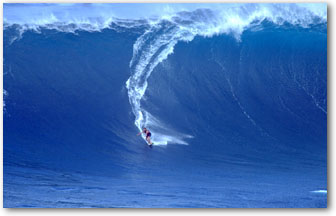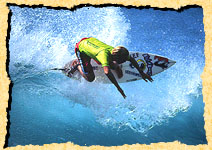

The Jaws Invitational boasts an all-star lineup and $100,000 in prize money. And that, say some top big-wave surfers, is why it shouldn't take place at all.
"It feels like four or five WWF wrestlers pulling on your arms and legs," says professional big-wave surfer Dave Kalama of the torture inflicted by Jaws, a monstrous wave-break (arguably the most feared in the world) that crescendos off the northern coast of Maui. "They're shaking you like a dirty carpet, and then a big, fat sumo jumps on your stomach to finish you off."
Such unpleasant conditions are precisely why Kalama and an elite coterie of surfers, including the reigning kahuna of extra-large waves, Laird Hamilton, don't want this month's Jaws Invitational to come off as planned. The event, the first of its kind, will showcase the radical sport of "tow-in" surfing, invented by Hamilton and company on Oahu about five years ago. Despite the exposure it could provide both themselves and their sport, Hamilton, Kalama, and friends are spurning the contest--not simply because it is an invasion of their turf, they say, but because of the disastrous consequences that could be awaiting the event's competitors.
Tow-in surfing is similar to the conventional variety, except that instead of paddling out to the break with his or her hands, the surfer is trawled behind a high-horsepower Jet Ski; the surfer then stands up and plummets down a thundering, 40-foot-high wall of water. Until now the sport has remained decidedly "for locals only." But that, thanks to the Jaws event's high profile, is certain to change this month. The field assembled includes such big-name veterans of surfing's professional circuit as Brock Little and Cheyne Horan. They'll compete for $100,000 in prize money, not to mention face-time with an international television audience. "Thanks to helicopter-mounted cameras, you'll practically be able to feel the wave through your TV," boasts Joe Tomlinson, a Rhode Island-based sports marketer handling the event.
The stuff of gripping TV perhaps, says Kalama, but that doesn't necessarily make the event, and its accompanying marketing bonanza, a wise idea. "It's like starting a climbing contest," he says, "and choosing Mount Everest as the site."
Of course, Kalama's concern for his fellow wave-riders isn't entirely altruistic. He's worried about the fallout. If somebody gets seriously hurt on Jaws, it might put a crimp in the renegade pastime. "It'll provide a wake-up call for the government to start regulating what we do," he laments. "That would suck." (see Breaking the Law: Problems for Tow-in Surfing with new JetSki regulations.)
Paia, Hawai`i, February 15, 1997
Rodney Kilborn, president of Maui-based Handsome Bugga Productions, announced today that the inaugural 1997 Jaws Invitational Tow surfing World Championships would be postponed until 1998.
Tow surfing is a radical new style of surfing in mammoth waves that has redefined the boundaries of big wave surfing. A relatively new sport, tow surfing is currently practiced by only a handful of the world's elite big wave surfers.
The Jaws venue, the most powerful break on Maui's North Shore, is widely regarded as the largest surfable wave on the planet. Waves at the site can reach 50- to 60-feet from trough to peak, exceeding the size of a four- to five-story building. Until the advent of tow surfing, waves of this size and ferocity were out of reach of even the most accomplished big wave surfers.
Surfers using specialized boards with footstraps are towed behind personal watercraft (Jet skis), where they are released to ride at speeds exceeding 40 mph. Tow boards are shorter, narrower and heavier than conventional big wave boards.
Expressing personal disappointment at having to delay the event for a year, Kilborn said: "We felt it was in the best interests of the athletes, the event and the successful launch of the sport of competitive Tow Surfing to wait until this time next year to hold the contest. The new dates of the holding period are February 1, 1998 through March 31, 1998."
Several reasons contributed to the decision to postpone including an unexpected conflict with Sony Pictures over 1997 dates and filming rights at the venue.
"Clearly we had no choice but to give in to Sony, although we feel strongly we were under no legal obligation to do so," said Kilborn. "They're a big company with a lot of money and well paid lawyers. However, we will continue to exercise our rights and continue with development the event."
The first news of the postponement came last January during a pre-event meeting with the leaders of the Tow Surfing movement on O`ahu, spearheaded by legendary big wave surfer Ken Bradshaw. In attendance were many of the competitors as well as prominent water sports film maker Larry Haynes.
Tow surfers currently planning to compete in the 1998 contest are O`ahu's Clyde Aikau, Ken Bradshaw, Brian Keaulana, Brock Little, Garrett McNamara, Dan Moore, and Charlie Walker, Kauai's Terry Chun and Titus Kinimaka and Maui's Archie Kalepa, Buzzy Kerbox and Victor Lopez. International competitors include Michel Larronde of France and Australia's Cheyne Horan, Ross Clarke-Jones and Tony Ray.
While disappointed, the competitors expressed their commitment to utilize the new event time frame to continue refining their tow surfing skills and address all safety, competition and judging parameters.
Discussions regarding the elements of risk in Tow Surfing and the Jaws venue have added to the mystique and controversy surrounding the event.
"There has been a lot of talk about us putting good people in a place where they will get hurt," said Kilborn. "The truth is, these guys are already Tow Surfing and are among the finest big wave athletes on the planet. This is the way they live their lives. For anyone to suggest that this event will in any way add more risk in their lives is crazy."
"The staff, cameramen and competitors are all individuals who have dedicated their lives to working and competing in the most challenging conditions," said Kilborn. "We won't be letting anyone go out there or compete in the event unless their skill level is high enough that they're not at risk simply for being out at Jaws."
"Sure, no one should be kidding themselves about the danger of surfing waves this big, and we are the first to tell anyone inexperienced at towing-in to leave it alone," said Kilborn. "Unless you are completely comfortable paddling into the biggest waves at Sunset or Waimea, you shouldn't even think about towing into big waves, 'cause your first ride could be your last'."
The event, under development since Fall 1995, has already developed a global media coverage program, including a one-hour event broadcast for network television in the United States. Prior to its postponement, the event was to be broadcast to over 300 million homes world-wide. Several international magazines are already planning major coverage.
"The most important thing for us to do now is keep our media and corporate relationships strong and work to assure that the 1998 event is bigger, better and watched by more people than the 1997 event would have been," said Kilborn. "There is so much worldwide excitement and enthusiasm about towing in and the World Championships at Jaws. Once we have launched the 1998 World Championships, no one will ever look at big wave competitive surfing the same way again."
Handsome Bugga Productions has produced surfing and windsurfing contests on Maui and O`ahu for 12 years and has developed an outstanding reputation for running peerless events.
Photographs of Jaws and Tow Surfing are available. For more information about the 1998 Jaws Invitational Tow Surfing World Championships please contact any of the following staff:
Event Director:
Rodney Kilborn
Handsome Bugga Productions
Phone/Fax: 808-575-9264
Director of Public Relations:
Carol Hogan, Ocean Promotion
Phone/Fax: 808-325-7400
E-mail her!
Media Coordinator:
Adam Nagler
Phone: 808-573-4018
Fax: 808-579-8556.
Executive Producer:
Joe Tomlinson
Phone: 401-842-0050
Fax: 401-841-0660

 Surf Home
Surf Home